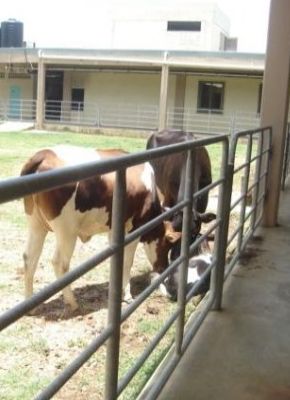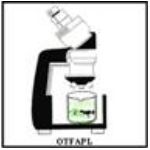VETM 1005 Outline
1. Purpose of the Course
This course is to introduce the student of Veterinary Medicine to the World of Animals from the standpoint of production, growth, economics and farm management. It is the one of three courses in which the student will be exposed to domestic and non-domestic animal species. It was designed specifically for the students in the five (5) year degree programme in Veterinary Medicine.
2. Course Concepts
This course contains an introduction to the concepts involved in designing an Intensive Animal Production System, an introduction to Ruminant Production [Sheep, Goats, Dairy, Beef Cattle and Buffaloes], Equine Production and the Production of Non-domestic Neo-tropical animal species.
i. To be able to list and describe the essential components and management practices involved in the production systems of the following animals: Dairy Cattle, Beef Cattle, Buffalo, Sheep, Goats, Aquatic species and some selected Neo-tropical Animals.
ii. To have an appreciation of the importance of the Neo-tropics with respect to the availability and production of Non-domestic animals.
4. Course Organization
This course is organized into five (5) parts that would be taught by Professor Gary Wayne Garcia as follows:
- Part 1: Anatomy and Physiology of Animals - You would not be examined on this section but the information will be given to you for you to get a better understanding of Animal Production.
- Part 2: Concepts for Designing Intensive Animal Production Systems – Prof. Gary Wayne Garcia (10 % of this course)
- Part 3: Ruminants – Prof. Gary Wayne Garcia (65 % of this course)
- Part 4: Equine Management – Prof. Gary Wayne Garcia (10 % of this course)
- Part 5: Non-domestic Neo-tropical Animals [Neo-tropical Animal Wildlife] – Prof. Gary Wayne Garcia (15 % of this course)
5. How to study for this Course
This course has been laid out for you in a very fluid manner. One week’s information flows into the other. In addition the PBL Cases for the respective subject will be presented to you the same week or the week following the week that the material was introduced to you. It is important therefore that you treat the PBL session with reverence and do not waste the time allocated to the PBL Sessions.
tree
7. Teaching Strategies
This is a blended course that would be presented to you in the face to face mode within the classroom, with Field Trips and with the use of the PBL (Problem Based Learning) methodology.
8.0 Assessment
Coursework will be worth a total of 40%, whereas final examinations would be 60%. The coursework breakdown is shown in the table below.
| Assessment | Weight |
| Mid Semester Quiz #1 | 20% |
| End of Semester Quiz #2 | 10% |
| Computer Course Information Usability Testing | 5% |
| Field Trip Attendance (2%) & Field Trip Report (2%) | 4% |
| Slide Show Report | 1% |
| Final Exam | 60% |
| Total | 100% |
9. Attendances/Absences
Students are expected to attend most (75%), if not all, classes. Students absent during an exam or when an assignment is due must have an excused absence (requested in writing) to avoid being awarded a zero mark. Discuss any planned absences with the lecturer prior to the absence. Emergency absences should be discussed immediately after return to class. Medical excuses must be signed by a physician.
10. Communication
Office hours: All students can communicate on line with the Course Coordinator and Course Lecturers on Line through the Google Group e-Mail account. I would like to advise ALL students that they also get a GMail e-mail address. It has very useful electronic information storage and Transfer Features.
In so doing, all students in the class would belong to a Google Group email account and website. This would afford us to have an “Open Classroom” in which learning and communication can take place 24 hours a day.
Communication policy: Use the course group email account. In this manner we could all communicate with each other 24 hours a day. All discussions must be polite.
- Thursdays 10:00am-11:00am (SBB 001)
- Fridays 9:00am-11:00 (SVM Amphi)
| Date | Time & Place | Topic | Name |
| Week 1 Thursday 22nd January | 10am-11am Steve Bennett | Course Introduction | Prof. G.W. Garcia |
| Friday 23rd January | 9am-11am Steve Bennett | Anatomy and Physiology of Animals [Brief Review] | Prof. G.W. Garcia |
| Week 2 Wednesday 28th January | 7- 10 pm Faculty of Agriculture, Main Campus | Slide Show | Prof. G.W. Garcia |
| Thursday 29th January | 10am-11am SVM Amphi. | Anatomy and Physiology of Animals [Brief Review] | Prof. G.W. Garcia |
| Friday 30th January | 9am-11am Steve Bennett | Concepts for Designing Intensive Animal Production Systems | Prof. G.W. Garcia |
| Week 3 Thursday 07th February | 10am-11am Steve Bennett | Concepts for Designing Intensive Animal Production Systems | Prof. G.W. Garcia |
| Friday 8th February | 10am-12am Steve Bennett | Introduction to Ruminant Production Systems | Prof. G.W. Garcia |
| Saturday 2nd Sunday 3rd | Weekend Field Trip Meet at 5:30 am 6:00 am to 9:00 am University Field Station Milking and Milking Management of Dairy Cattle Animal Housing Forages 10:00 am to 2pm Sugarcane Feeds Centre Animal Housing Bio-gas digestors Animal Abattoirs Aquaculture Meet Sunday 8:00 am 9:00 am to 1 pm Emperor Valley Zoo | ||
| Week 4 Thursday 12th February | 10am-11am Steve Bennett | Tropical Hair Sheep Production | Prof. G.W. Garcia |
| Friday 13th February | 9am-11am SVM Amphi | Tropical Hair Sheep Production | Prof. G.W. Garcia |
| Week 5 Thursday 19th February | 10am-11am Steve Bennett | Goat Production in the Tropics Directed Readings | Prof. G.W. Garcia |
| Friday 20th February | 9am-11am SVM Amphi | Goat Production in the Tropics Directed Readings | Prof. G.W. Garcia |
| Week 6 Thursday 26th February | 10am-11am Steve Bennett | Dairy Cattle Production | Prof. G.W. Garcia |
| Friday 27th February | 9am-11am SVM Amphi | Dairy Cattle Production | Prof. G.W. Garcia |
| Week 7 Thursday 05th March | 10am-11am Steve Bennett | Beef Cattle & Water Buffalo Production | Prof. G.W. Garcia |
| Friday 06th March | 9am-11am SVM Amphi | Free for Studying | Prof. G.W. Garcia |
| Week 8 Thursday 12th March | 10am-11am Steve Bennett | Beef Cattle & Water Buffalo Production | Prof. G.W. Garcia |
| Friday 13th March | 9am-11am SVM Amphi | Quiz #1 | Prof. G.W. Garcia |
| Week 9 Thursday 19th March | 10am-11am Steve Bennett | Neo-tropical Animals | Prof. G.W. Garcia |
| Friday 20th March | 9am-11am SVM Amphi | Neo-tropical Animals | Prof. G.W. Garcia |
| Week 10 Thursday 26th March | 10am-11am Steve Bennett | Neo-tropical Animals | Prof. G.W. Garcia |
| Friday 27th March | 9am-11am SVM Amphi | ||
| Week 11 Thursday 2nd April | 10am-11am Steve Bennett | Neo-tropical Animals | Prof. G.W. Garcia |
| Friday 3rd April | NO CLASS | GOOD FRIDAY | |
| Week 12 Thursday 9th April | 10am-11am Steve Bennett | Equine Production | Prof. G.W. Garcia |
| Friday 10th April | 9am-11am SVM Amphi | Quiz #2 [2 hours] | Prof. G.W. Garcia |
| Week 13 Thursday 16th April | 10am-11am Steve Bennett | Review | Prof. G.W. Garcia |
| Friday 17th April | 9am-11am SVM Amphi | Review | Prof. G.W. Garcia |
| Week of Semester [Dates] | PBL Topic |
| 1] 19/1 to 23/1 | |
| 2] 26/2 to 30/1 | |
| Wednesday 28th January | Special Slide Session 7- 10 PM Lecture Room B, Sir Frank Stockdale Building Faculty of Science and Agriculture St Augustine Campus (1%) |
| 3] 2/2 to 6/2 | PBL#1: Sudden Death in Calves |
| SATURDAY 7th February | Field Trip 5:30 am - UFS Dairy - Sugarcane Feeds Centre (2%) |
| SUNDAY 8th February | 9:00 AM - Emperor Valley Zoo (2%) |
| 4] 9/2 to 13/2 | PBL#2: No Kidding |
| 5] 16/2 to 20/2 | Carnival Monday and Tuesday NO PBL |
| 6] 23/2 to 27/2 | PBL #3: A Fat Duck |
| 7] 2/3 to 6/3 | PBL#4: Persistent Mastitis |
| 8] 9/3 to 13/3 | PBL#5: 3 Chickens for $30 |
| 9] 16/3 to 20/3 | PBL#6: Chicken Farm Dilemma |
| 10] 23/3 to 27/4 | PBL#7: Floating Tilapia and Cascadura |
| 11] 30/3 to 3/4 | |
| 12] 6/4 to 10/4 | |
| 13] 13/4 to 17/4 |
14. Required Reading
All required reading will be available from the website of The Open School of Tropical Animal Science and Production.
Website: www12.brinkster.com/ostasp/index.aspx

